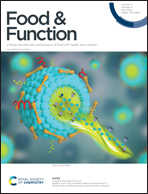Sulfated galactofucan from Sargassum thunbergii induces senescence in human lung cancer A549 cells
Abstract
Isolated compounds from Sargassum thunbergii (S. thunbergii) have shown to exhibit diverse biological activities, including anti-cancer activity. In this study, we examined the effect of sulfated galactofucan (SWZ-4-H), which was successfully isolated from S. thunbergii, and its underlying mechanism on human lung cancer (LC) A549 cell growth in vitro and in vivo. In vitro experiment indicated that SWZ-4-H decreased cell growth and number in a dose-dependent manner (P < 0.05 vs. control). Besides, cells treated with SWZ-4-H had irregular morphology, including increased cell volumes, and large nuclei, which suggested senescence-like changes. Moreover, SWZ-4-H increased senescence-related β-galactosidase (SA-β-Gal) staining in a dose-dependent manner; however, while lower (1 mg mL−1) concentration induced mainly senescence without causing cell death, higher dosage (3 mg mL−1) induced both senescence and cell death. The effect of SWZ-4-H was further confirmed by analyzing the expression of p53, p21, p16, and Rb (p-RB); SWZ-4-H significantly increased the expression of p53, p21, and p16 and decreased phosphorylated Rb (p-RB) in a dose-dependent manner. Moreover, in vivo experiment showed that SWZ-4-H significantly reduced the tumor volume without affecting the body weight. To sum up, our data indicated that SWZ-4-H could induce lung cancer senescence by regulating p53, p21, p16, and p-Rb, thus providing a novel perspective on anti-cancer mechanisms of SWZ-4-H in human lung cancer A549 cells.



 Please wait while we load your content...
Please wait while we load your content...